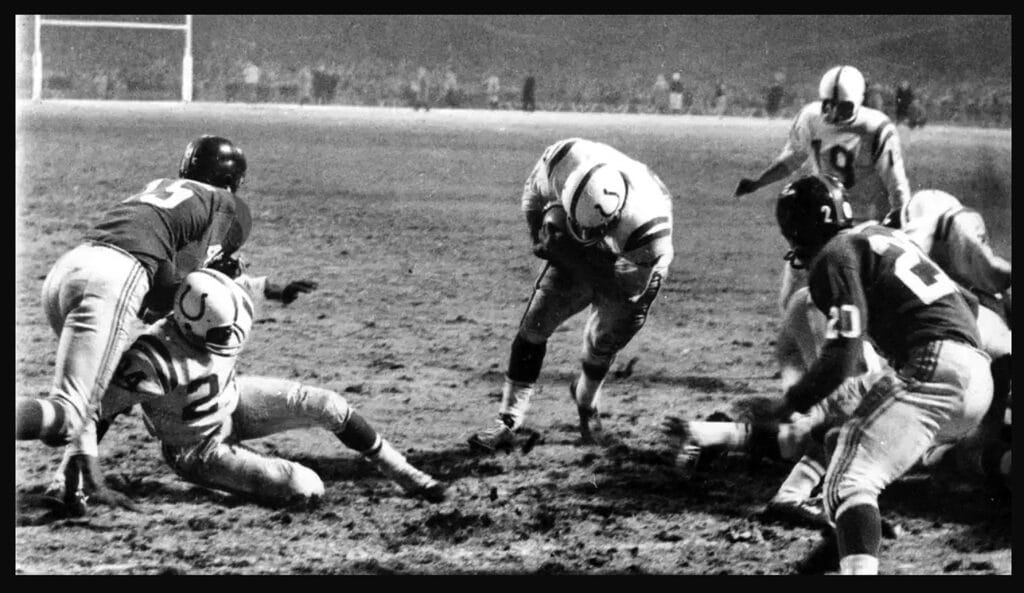By the 1920s, baseball and prizefighting were the two major American sports. College football was huge. However, it wasn’t until the mid-1950s and the advent of television that the pro game took hold.
Whatever the attraction, Yankee Stadium was where history was made.
Starting in the Twenties, the Stadium was host to many great fights.
They included such championship brawls as the 1939 Joe Louis-Max Schmeling fight, in which Louis avenged an earlier defeat; plus those between Tony Zale and Rocky Graziano, Sugar Ray Robinson and Kid Gavilan, Sandy Sadler and Willie Pep, Rocky Marciano and Ezzard Charles, and Ingemar Johansson and Floyd Patterson.

A favorite was the June 28, 1939 bout between Louis and Tony “Two-Ton” Galento. The latter was known as “the Battlin’ Barkeep” as he tended bar in The Bronx in between ring dates. Imagine the conversation.
GALENTO: Got to take the night off, boss.
BOSS: And why?
GALENTO: Gotta take the train to the Stadium.
BOSS: What for?
GALENTO: The fights!
BOSS: Yeah?
GALENTO: Gotta step into the ring with
Joe Louis. See you when it’s over!
(Louis won in a fourth-round TKO, even though Galento staggered the champ with a second-round haymaker.)
By the 1950s, the Yankee Stadium neighborhood was changing rapidly. The flight to Queens and Long Island was in full swing. Plus, fights were now televised.
On Sept. 28, 1976, at the newly-refurbished Stadium, defending heavyweight champ Muhammad Ali took on challenger Ken Norton. By now, Ali was 37. His best days were behind him. Ali won in a decision, one hotly disputed in the media and by the fans. By 1976, the crime situation in The Bronx was becoming out-of-control. A disparaging article on the fight in Sports Illustrated trashed the building as “Junkie Stadium,” while observing local thugs pawing the ladies in attendance. Prize fights would have to take place elsewhere.
But not football games. New York, in the early and mid-1900s, was a capital for Ellis Island immigrants and their offspring. The most famous college team in America was the Fighting Irish of Notre Dame. The Irish often played at Yankee Stadium and the “D” train and Number Four trains were packed with the “subway alumni,” those ethnic Catholics came to cheer the Irish of Knute Rockne and Frank Leahy and such Heisman Trophy winners as Angelo Bertelli, Johnny Lujack, Leon Hart, Johnny Lattner, and Paul Hourning.
A zenith was reached on Nov. 9, 1946. Both Notre Dame and the Army squad coached by Earl Blaik were undefeated.
It was more than a game. The postwar
era represented an unprecedented
peak of American history. Victorious in the European and Asian theaters of World War II, the game showcased the pride and greatness of this now-invincible nation. The game was the most anticipated match in college football history, ending in a thrilling, but inconclusive 0-0 tie.
With the nationally-televised Dec. 30, 1958 National Football League title game between the New York Giants and the Baltimore Colts, pro football made its debut as the new national pastime.
The game, naturally, took place at Yankee Stadium. The daylight turned from dusk to darkness as the two teams battled each other to a heart-stopping overtime barn burner, with the Colts and their quarterback great, Johnny Unitas, winning on a one-yard touchdown run by Alan Ameche.
That day, the Giants were led by quarterback Y.A. Tittle, plus Kyle Rote and matinee idol Frank Gifford in the backfield. The Giants were on a roll of their own. Two years earlier, while also playing at Yankee Stadium, the Giants defeated the Chicago Bears in the “tennis shoes’” game to capture the NFL crown. (The field was covered with ice. Head coach Jim Lee Howell instructed his charges to play in sneakers, an idea that worked swimmingly.)
At Yankee Stadium, the Giants, under Allie Sherman, won consecutive Eastern Conference titles in 1961, 1962, and 1963, only to lose to the Vince Lombardi Green Bay Packers and the George Halas Bears in the title games. By 1972, the Giants were through with the House That Ruth Built, settling eventually in the swamps of New Jersey.
The year 2008 was the final one for the 1923 Yankee Stadium. The team stayed in The Bronx, which was great news. It’s not the same. The players, then and now, are not sentimental about these matters. In the old Yankee Stadium, however, players knew they were competing on turf where legends had roamed.
Today’s Yankee Stadium is just another ballpark hosting just another team. The old Yankees were under unbearable pressure, year after year, to win pennants and World Series titles. Managers and players suffered from ulcers, drinking problems, failed marriages. In 1961, while chasing Babe Ruth’s single season home run record, Roger Maris got so nervous that his hair began falling out. That pressure is no longer there.
There’s no need to despair. A century hence, the current Yankee Stadium, glorious as it is now, will grow old. A new Yankee Stadium, one constructed on ground where the 1923 Stadium once stood, will be constructed. History wheels will churn again. Let’s just hope that no youngster says to his pop, “Daddy, who was that man, Babe Ruth?”































